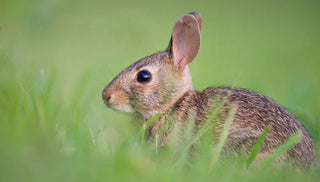Rabbits in the garden can cause a lot of heartache. Though they rarely do as much damage as deer, woodchucks or raccoons, that's little comfort when they've munched your peas and eaten the buds off your lilies.
If you suspect there's a rabbit causing problems in your garden, but you haven't actually seen one, the telltale signs of damage include: delicately nibbled leaves and stems, primarily on young or newly emerging plants; chewed tree bark near ground level, especially on saplings, shrubs and fruit trees; and small round rabbit droppings.
For nature-friendly gardeners, the ideal solution to wildlife problems is peaceful coexistence. The challenge with rabbits is to simply keep them from eating the things you don't want them to eat. This requires more brains than brawn. So as with any counterintelligence effort, let's start by getting to know the other guy.
Think Like a Rabbit
One thing rabbits must spend a lot of time thinking about is making more bunnies. In a single breeding season, one rabbit couple can produce 18 baby bunnies! This is another good reason why when it comes to rabbit problems, a strategy of coexistence is a wise one.
Rabbits are timid creatures and they prefer to feed in an area where they can quickly take cover when frightened. This means you'll often find more rabbit damage around the edges of your garden than in the center. Removing easy hiding places, such as brush piles, stone piles and areas of tall grass, can make dining in your garden much less appealing.

If they're hungry enough, rabbits will eat just about anything green. But if food sources are abundant, they prefer to eat young plants and tender new growth. Once plants have been growing for a couple months, their stems and leaves toughen up and become less tempting. If you intensify your rabbit protection in the early season, you'll probably have fewer problems later on.
What foods do rabbits fantasize about? Alfalfa and clover are at the top of the list. So if you have room in your yard for a small patch of these crops, you may find that local rabbits prefer hanging out in the alfalfa rather than chomping down on your garden veggies.
Three Rabbit Control Options
There are three primary strategies for keeping rabbits from eating your favorite plants: targeted coverage, repellents and fencing.
1. Targeted Coverage:
If there's a particular plant or crop that you know rabbits can't resist (such as peas and beans) or a plant you don't want to risk losing (such as something exotic that you've grown from seed), you can focus your efforts on protecting just that area. One option is to cover or wrap the plants with garden fabric. You can use Super Hoops to support the fabric. This is a quick and easy way to protect an entire bed of salad greens or an area of newly planted broccoli. Be sure that the fabric gets securely anchored on all four sides.
 Super Hoops support a layer of garden fabric.
Super Hoops support a layer of garden fabric.You can also use 3/4" mesh fencing, also known as poultry mesh or chicken wire, to encircle susceptible plants or create a protective tunnel for an entire row. To protect trees and other landscape plants from winter nibbling, wrap the bottom of the trunk (loosely) with hardware cloth or 3/4" mesh fencing, to a height that's at least a foot above winter snow levels. As with other fencing, it's best if it can also extend at least a couple inches below the soil surface (see below).
2. Repellents:
If there are plenty of other food choices available, rabbits may be deterred from eating a particular crop by applying granular repellent, clip-on garlic odor repellents, or fish emulsion. But if they've already grown fond of the crop, or there's nothing else tempting nearby, repellents may not be effective. That said, repellent sprays can be used to break a feeding cycle and give young plants enough growing time to get ahead of the rabbits. Remember that most repellents need to be reapplied every few days, and especially after heavy rains.
3. Fencing:
If rabbits are the only varmints causing problems in your vegetable garden, a simple 2' fence made of poultry mesh will usually solve the problem. Make sure the mesh is 1" diameter or smaller (3/4" is safer) and that you secure it to sturdy stakes. The fence needs to extend down into the soil to discourage burrowing — 6" if you can. This means that if you want a 2' fence, you'll need to purchase 3' fencing. If your problem is jackrabbits, rather than garden variety cottontails, or if your cottontails are particularly athletic, you will need to make the fence a little taller. For added protection and to deter jumping, bend the top 5-6" of the fence away from the garden. You can protect vulnerable plants with self-supporting pop-up nets. These enclosures come in several sizes and can be anchored to the ground right in the garden or used in conjunction a raised bed.
 Tall Pest Control Pop-Ups protect crops from pests, diseases and some animals, including rabbits.
Tall Pest Control Pop-Ups protect crops from pests, diseases and some animals, including rabbits.For a taller enclosure, consider a Crop Cage. Some types of fencing can be easily cut to size and, if you wish, can be removed at season's end and re-used the following year. If your garden is already surrounded by a fence and rabbits are still getting in, add a 2-3 ft. band of chicken wire to the bottom of the fence, making sure to bury at least 6" of it below ground to prevent burrowing. Electric fencing, though more expensive and a bit fussy to maintain, is a good investment, especially if you also have woodchuck problems.





